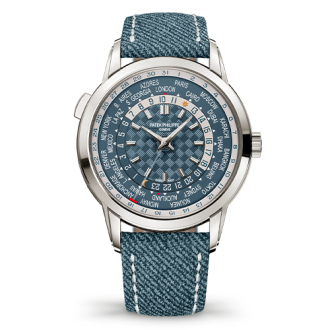This new-generation World Time is distinguished by a patented world first: a date display synchronized with local time; that is, the time in the time zone selected at the 12 o’clock position on the city disk and indicated by the center hands. The new caliber 240 HU C self-winding movement, with an innovative differential system, indicates the date on the periphery of the dial by means of a center hand in transparent glass with a red hammer-head-style tip. The elegant white-gold case frames a dial in blue-gray opaline, its center adorned with a “carbon” motif. This new technical evolution in the Patek Philippe World Time watches now enriches the choice of travel watches proposed by the manufacture.
Introduced in the 1930s, the era of the first transatlantic flights, and based on an invention by the Genevan master watchmaker Louis Cottier, the renowned Patek Philippe World Time has been technically optimized continually ever since. From the early 1950s onwards this function has made it possible to read off the time simultaneously and permanently in the 24 time zones, by means of two mobile disks (a city disk and a 24-hour disk) while also benefiting from a local-time display (in a time zone selected at the 12 o’clock position) by center hour and minute hands. This ingenious system, combined with dial centers often adorned with colorful maps in Grand Feu cloisonné enamel or hand- guilloched decorations, has made this complication one of the most recognizable of Patek Philippe models –and one of the most sought after by devotees of splendid mechanisms.

Innovative territory
In 1999, Patek Philippe announced a major improvement in the functionality of the World Time with an exclusive patented mechanism whereby, when its owner changes time zones, a single pressure on a push-piece suffices to adjust all the displays together (city disk, 24-hour disk and center hour hand) in one-hour steps –without affecting the rate accuracy of the minutes and seconds. This innovation was introduced in the year 2000 with the launch of Reference 5110. More recently, the engineers have also paired the World Time with two of the manufacture’s other most emblematic complications. In 2016 they unveiled the World Time Chronograph Reference 5930, with a caliber CH 28-520 HU self-winding movement. In 2017, on the occasion of the Grand Exhibition in New York, Patek Philippe presented the first World Time minute repeater that always chimes the local time: Reference 5531, with a caliber R 27 HU self-winding movement, in a limited edition of ten watches. This model joined the regular collection in 2018.

A new alliance of functions useful in everyday life
The manufacture is now marking a new milestone in the history of the Patek Philippe World Time watch by endowing it for the first time with a date display. While normally quite straightforward, here this function posed a real technical challenge. Other world-time watches equipped with a date indicator always oblige the traveler, when changing time zones, to adjust the time zone and the date independently. Patek Philippe, however, was intent on making the user experience as practical and comfortable as possible, and tasked its engineers with coupling the date display mechanically with the local time (the time zone selected at 12 o’clock and indicated by the center hands) with no need for correction. Meeting this challenge required, therefore, that the date adjust automatically in the two situations entailing a change: past midnight, when the date advances to that of the following day; and when crossing the International Date Line (in the middle of the Pacific Ocean) from west to east, where the date goes back by a day – as Phileas Fogg famously forgets in the Jules Verne novel “Around the World in Eighty Days”. (He believes that he has lost his bet by a day, an error that he would have avoided had he been wearing the new Reference 5330G-001). Here, as in the World Time Minute Repeater Reference 5531, accommodating the two complications in the same movement was not the only difficulty: they had to be made to interact, with the World Time controlling the date display (just as it controls the minute repeater in Reference 5531). Therefore, the date mechanism had to be able to function in either direction, backwards or forwards, during a date change, and to do so reliably, with no risk of damage to the movement.

An innovative, patented differential
To provide this useful, exclusive and user-friendly function, the manufacture developed a new movement, caliber 240 HU C, based on the caliber 240 HU ultra-thin self-winding movement that has equipped the Patek Philippe World Time watches without additional functions since the year 2000. The first distinguishing feature of this innovative movement is its date-display module, which alone comprises 70 parts. A patented central differential system comprising two concentric star-type gear wheels manages the local-time date. When the outer star (of larger diameter and with 62 teeth) turns clockwise, the date hand advances clockwise by one notch. When the inner star (with 31 teeth) turns clockwise the date hand moves back counterclockwise by a notch. When the two stars turn clockwise together (which should imply simultaneously a forward and a backward movement of the date hand) the differential allows this hand to remain stationary. Each pressure on the pusher positioned at 10 o’clock therefore serves to adjust, in one-hour steps, not only the city disk, the 24-hour disk and the center hour hand, but henceforth –where applicable –the date, in either direction. Complex and yet so easy to operate, this system perfectly illustrates Patek Philippe’s creative philosophy of putting the user first. Furthermore, despite its additional mechanism, the new caliber 240 HU C movement is barely 0.7 millimeters thicker than caliber 240 HU (4.58 mm instead of 3.88 mm) allowing it be housed in a slender, elegant case.
Original, legible displays
The second distinguishing feature of the new World Time Reference 5330G-001 is its date display mode. Patek Philippe opted for a center hand with a hammer-shaped tip in red lacquer that moves along a transfer-printed scale from 1 to 31 at the outer edge of the dial on a beveled, silvery flange that creates a beautiful sense of depth. To avoid this relatively static hand’s disturbing the legibility of the other information, the manufacture’s engineers conceived –for the first time at Patek Philippe – a transparent hand made of glass.

Character shows in its face
As with all Patek Philippe World Time watches, the new Reference 5330G-001 stands out by its refined and highly distinctive appearance. Its opaline dial center in an elegant shade of blue-gray is adorned with a carbon motif, adding a dynamic modern touch. The 24-hour disk is subdivided into day and night zones, identified respectively by a small gilt sun on a silvery background symbolizing noon and a gilt crescent moon on a blue-gray ground symbolizing midnight. On the city disk, a red dot between Auckland and Midway marks the International Date Line. Faceted dauphine-style hands and faceted applied baton- style hour markers, all in white gold with a white luminescent coating, indicate local time in the time zone selected at the 12 o’clock position. The fully polished white-gold case, 40 mm in diameter, catches the eye with its curved two-tier fluted lugs. Its sapphire-crystal back affords a private view of the architecture of the new caliber 240 HU C self-winding movement and the painstaking finishing touches lavished on its parts.
A calfskin strap embossed with a denim motif, in blue gray with white hand-stitching, echoes the color of the dial. It is secured by a fold-over clasp in white gold.

Time zones and the International Date Line
It was long the case that every country- if not every city –had its own local time, based more or less on the longitude, and travelers constantly had to adjust the indications on their watches. But the era of rapid growth in transport and communications brought with it the need to unify the time system. In 1884, the International Meridian Conference in Washington resulted in the decision to divide the planet into 24 time zones, each covering 15 degrees of longitude (one hour) and to take as reference point (longitude 0) the Greenwich meridian, which navigators were already using for that purpose.
According to this system, the time zone in which Auckland (New Zealand) is situated is 12 hours ahead of that of Greenwich (UTC + 12). It is therefore the first to pass to the following day. On the other hand, the time zone applying to Midway (an atoll and area of the United States in the North Pacific) is 11 hours behind Greenwich (UTC -11). Thus, it is the last to pass to the following day. In our example, when one is travelling westward from Midway to Auckland it is therefore necessary to advance the date by a day. And when one is travelling eastward from Auckland to Midway the date must move back by a day. The International Date Line, which is situated between the Auckland and Midway time zones (and has not been the subject of any international treaty) zigzags around the 180°meridian in the middle of the Pacific Ocean at the will of the different islands’ choices of time zone.
But this system is nevertheless particular in one respect. During the time segment from 11 a.m. to noon in London, it is between midnight and 1 a.m. in Midway and between 11 p.m. and midnight in Auckland (unless daylight saving is in force). The entire planet is therefore on the same date for one hour. Thanks to its patented differential system, the new World Time Reference 5330G-001 respects this case by keeping the date stationary even when another time zone is selected using the push-piece at 10 o’clock. Without this differential system, in the time segment where the date is identical in all the time zones, that is, at midnight, when its owner crossed the International Date Line located between Auckland and Midway the watch would send two contradictory signals to the same star-wheel, one to advance the date by a day, the other to subtract a day – which would block the movement.







